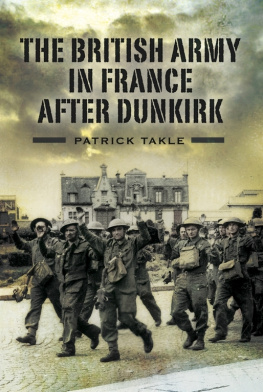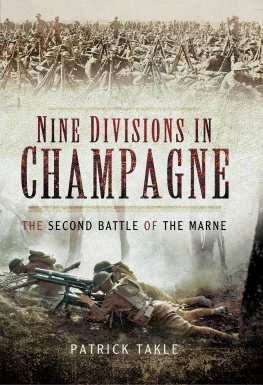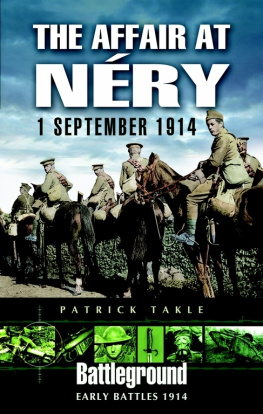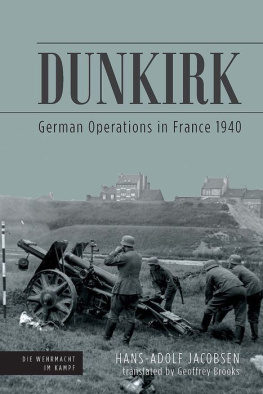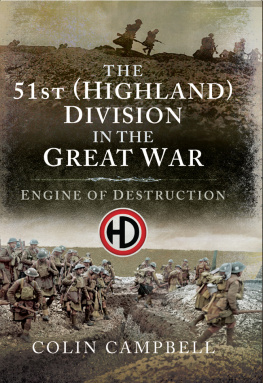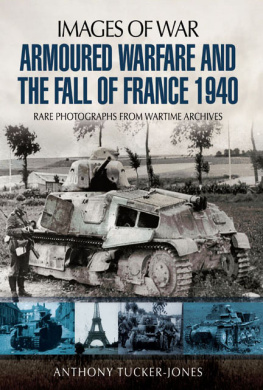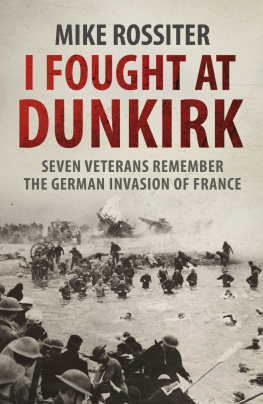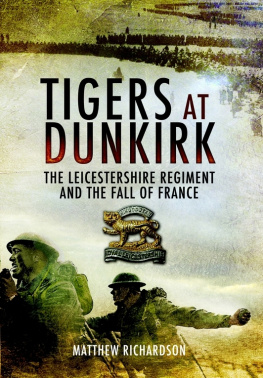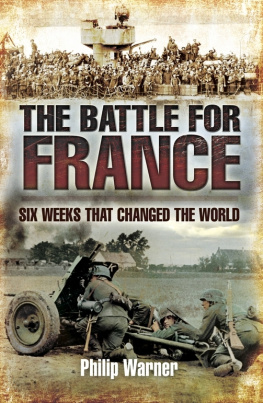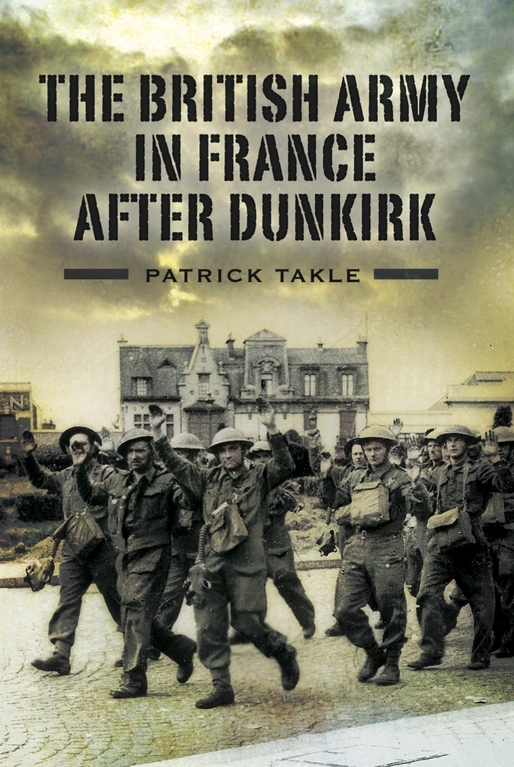I wish to acknowledge my gratitude to the following for their help and permission to publish extracts, photographs or maps:
M. Jean Claude Claire, Mayor of Veules-les-Roses, for his support and help in obtaining photographs of the tragic events in Veules-les-Roses in June 1940 and for permission to use these photographs. I particularly want to thank Mme. Emmanuelle Thivillier for providing copies of the photographs and of documents from the archives of Veules-les-Roses. Special thanks are also due to M. Yvon Debuire of Nry who translated documents and provided invaluable help in transmitting documents and photographs.
The Royal United Services Institute and its librarian John Montgomery, who provided ready access to their splendid collection of books.
Mr Andrew Orgill, librarian of the Royal Military Academy Sandhurst Library, for assistance and providing access to the Academys many rare regimental histories.
The Library and staff of the Imperial War Museum for access to the Rommel Diaries.
Captain Fleming Jensen of Aarhus, Denmark for his introduction to the Maginot Line.
Finally, warm thanks to the staff of Pen & Sword for their patient help in drawing this book together and particularly to my editor, Bobby Gainher, for his assistance and forbearance.
CHAPTER 1
The Creation of the British Expeditionary Force in France
Following its Declaration of War on 3 September 1939, Britain began assembling an Expeditionary Force of four divisions in France (exactly the same as in 1914), with the aim of persuading the Germans to leave Poland, which had been the direct cause of the ultimatum to the Germans. Although the Royal Navy, under its newly appointed First Lord of the Admiralty, Winston Churchill, began warlike operations immediately, the rest of the British Government had no clear idea how the new war was to be won. The Allies seemed to be at pains not to antagonize the Germans by attacking them while they were still occupied in subduing Poland. So while German ships were attacked, care was taken not to bomb German cities with anything more dangerous than leaflets, while equipping and training for war proceeded slowly. Of course, it was difficult for the Allies actually to intervene militarily in Poland, so their preparations for a new war assumed it would proceed very much like the start of the First World War, with a German attack through Belgium followed by years of grim fighting in northern France.
In August 1914, the Germans had attacked France with seven large armies, of which three of them, on their right flank, had been used to invade neutral Belgium and then march in a wide arc towards Paris. These three armies comprised a force of some twenty-six infantry and five cavalry divisions, far stronger than the Allied forces which marched into Belgium to oppose them. The Allied left wing comprised the BEF of just four infantry and one cavalry division, and the French Fifth Army of ten infantry and two cavalry divisions. Outnumbered and outgunned the Allies had no alternative but to fall back in a fighting retreat to the River Marne. There a counter-attack from Paris on the German outer flank was mounted, and the hitherto retreating Allies were able to turn and drive the Germans back to the River Aisne, where the Germans dug in. This resulted in the stalemate of trench warfare for four years until the Allies eventually wore the Germans down and, in late 1918, were able to drive them out of France.
In 1939, Germany was still busy rebuilding its forces and was desperate not to become entangled once again in another long war of attrition fought on at least two fronts. Nevertheless, having absorbed the lands and industries of Austria and most of Czechoslovakia, the German Army was already much stronger in troops and equipment in 1939 than it had been even in 1938, when Chamberlain had reluctantly agreed to Hitlers demands at Munich. A non-aggression treaty with Russia took care of the immediate two-front problem, while Hitler sought radical solutions to achieve swift military decisions and avoid stalemate in the West. The campaign in the East against Poland, even though conducted with large bodies of marching infantry supported by horse-drawn artillery, also enabled the German Army to practise many of its new ideas, such as armoured (panzer) columns with their own artillery, engineers and integral motorized infantry speeding through and around the main enemy defences, closely supported by dive-bombers. The defeat of Poland was a major military success for Germany and its speedy conclusion by 27 September 1939 convinced many of the doubters that Hitlers reconstituted forces could also knock out France and Britain.
As in 1914, Britain and France were allied and expected a major German attack in the north of France. This expectation was based partly on the experience of centuries of history, as invaders chose to attack France through the Low Countries. It was also partly based on the French experience during the First World War, when they found that strongly defended old fortifications stood up well, even against modern artillery. As a result, during the 1930s, France had constructed a series of strong, interlinked, defensive fortifications along part of its eastern border from Switzerland to Longuyon at the edge of Luxembourg, called the Maginot Line. These fortifications were manned with some ten divisions, behind which were intended to be mobile reserves and an Army of Manoeuvre, which could be used to block any enemy breakthroughs. The French believed this combination of fixed forts and multiple defensive lines of infantry would, as in 1914, hold the Germans in this part of the frontier. the area of decision would thus be in the unfortified area on the left of the Maginot Line behind the border with Belgium.
By October 1939, the French had fully mobilized and the first British troops had started to arrive in France. To meet the anticipated German offensive, Britain had, by early 1940, increased its army in France to eight fighting infantry divisions, each of three brigades, organized into three corps. The army was well supported by a strong artillery component, which included field, anti-tank and anti-aircraft units. There was no armoured division (it was still in England and did not begin landing until May), but the BEF did have some ten armoured regiments. However, of these, there were only two heavy tank regiments in a single armoured brigade, and most of the formerly horsed cavalry and yeomanry regiments had been converted into lightly armoured reconnaissance units attached to infantry formations. The single armoured brigade was equipped with heavily armoured Matilda infantry tanks, but even these were mostly Mark I (armed with just machine guns) as there were only limited numbers of the Mark II, which mounted a 2-pounder gun. There were also two strong Royal Air Force contingents based in France: the Advanced Air Striking Force (AASF) consisted mainly of bombers designed to attack targets in Germany; and the Air Component which was a mixed force of fighters and bombers designed to support the BEF directly. Moreover, the British had also established a series of bases in northern France to support a far larger army, which was being equipped and trained for a rerun of the attrition of the First World War.
The French had mobilized over one hundred divisions, but the British, with a similar population, had, by April 1940, only managed to send ten fighting divisions to France (including two recently arrived divisions the two-brigade 5th Division and the 51st Highland Division). A major problem for the British was a lack of trained and equipped artillery regiments to support infantry formations. This laggardly British effort aroused considerable French criticism as a result of which, in the early spring, partly to convince the French of the seriousness of British intentions, Britain sent over three more infantry divisions (the 12th, 23rd and 46th). These recently embodied territorial divisions came with no integral artillery or armour and were supported only by some Royal Engineer squadrons intended to assist construction activities. They comprised a total of some 18,000 very lightly armed infantry, who were grossly under-trained, having been used mainly for guard duties since their mobilization. Their role was to make up numbers, act as labour on the British Lines of Communication and continue the construction of the railway yards, bases and depots for the expanding BEF.

